
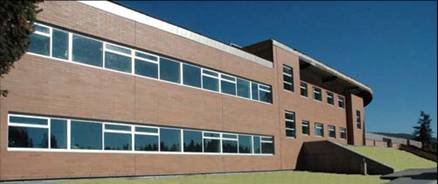
Thompson Rivers University
Workshop 2007
Williams Lake BC, May 18-20, 2007
Congratulations to the planning team for a very successful event.
If you wish to view the presentations that were given on the weekend, please visit this page.| Quick Links | ||
| Accommodations in Williams Lake for Workshop Attendees | Online Map of the area | Downloadable Map of the area |
| Adobe Acrobat Reader - required for some of these documents | Items that will be raffled | |
Stewardship in Transition: Impacts and Adaptations in a Changing Climate
The Stewardship Workshop 2007 is being held in the City of Williams Lake, which is located in the Cariboo Chilcotin. I thought many of you would like to have information about the natural areas that you will be visiting. This is one of the most beautiful areas of the province (I am only slightly biased having lived here for 28 years). I love it because of the wide range of ecosystems that are accessible from the city. You will have a chance to visit each ecosystem in the company of local naturalists that know the areas well as part of a workshop or field trip. You can also see samples of each just by walking in the Williams Lake River Valley (more below). There will be opportunities for excellent birding, butterfly watching and great botanizing. Bring your binoculars, your camera, and a wide range of clothes for all types of weather. At this time of year the weather can range from hot and dry to snowing and sometimes on the same weekend. Below is a brief description of each type of ecosystem you might visit while here and some pictures of the flora and fauna. You can find more information at http://www.ccconserv.org/ and click on grasslands, wetlands, forests and waterways and salmonids
Grasslands
Big Horn Sheep
Native grasslands are natural areas dominated by native grasses or dryland shrubs. They occupy less than 1% of B.C. but are home to more than 35% of all plant species and more than 30% of the rare and endangered species of the province. Grasslands of the Cariboo-Chilcotin region of B.C. are among the most natural grasslands remaining in North America. They are especially beautiful in spring when the balsam root are in full bloom, the grasses are green and the blue birds are busy raising their young.
Big Horn Sheep
Grasslands occur in the warmest and driest climates of British Columbia. Most are found at low elevations in the major valleys of central and southern interior of B.C., where little precipitation falls due to the rainshadow effect of the Coast Mountains. These valleys contain spectacular landforms resulting from the erosion of materials deposited by glacial lakes and rivers.
_resize.jpg)
Cariboo Chilcotin Shooting Star
Grasslands of B.C. are characterized by bunchgrasses, especially bluebunch wheatgrass. Grasslands of B.C. occur in three elevation zones. The hot, dry Lower Grasslands has abundant big sagebrush, bluebunch wheatgrass, prickly-pear cactus, and a microbiotic soil crust, composed of lichens, mosses, and cyanobacteria. This crust helps to conserve soil moisture and protect the soil from erosion, as well as adding nitrogen to the soil. Lower grasslands can be seen in the bottom of Farwell Canyon and in the Chilcotin River valley west of Williams Lake.
Mallard ducks
Middle Grasslands are slightly cooler and have little or no big sagebrush and a greater variety of flowering plants. Bluebunch wheatgrass and needle-grass dominate the vegetation but many flowering plants, including Balsamroot, mariposa lily, and wild blue flax, occur among the grasses. Upper Grasslands are the coolest and wettest of B.C.’s southern interior grasslands. Sagebrush is absent and islands of trees are common, especially Douglas-fir and trembling aspen. Porcupine grass, bluebunch wheatgrass, and spreading needlegrass are principal grasses in the Cariboo-Chilcotin. Upper Grasslands can be explored on Becher’s Prairie along Highway 20 west of Williams Lake (there will be a field trip to this area).
California bighorn sheep and mule deer roam the grasslands along the Fraser and Chilcotin rivers. Western meadow lark, vesper sparrow, long-billed curlew, horned lark, sharp-tailed grouse, and many other bird species can easily be seen in the grasslands. Because the grasslands are warm and sunny and contain a diversity of food plants, many species of butterflies are also present. Cattle grazing is seen in all parts of the grasslands. Several salmon species use the Chilko and Chilcotin Rivers that flow through the grasslands east of Williams Lake.
Mountain Blue Bird
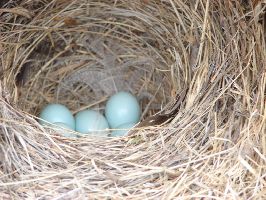
Mountain Blue Bird nest
_resize.jpg)
Mountain Blue Bird nest
For more information about grasslands link to www.bcgrasslands.org and click on understanding grasslands.
Interior Douglas-fir Forests
Douglas fir forests prevail in warm valley bottoms, on valley slopes and on dry plateaus just above the grasslands and interspersed within more moist sections of the grasslands. It creates a picturesque park like setting. Wildfires are a natural occurrence and influence the forest ecosystem. The thick bark of the old-growth Douglas fir enables them to survive low-intensity fires while the young trees and understory are burned and as a result there are pure Douglas-fir climax stands. Other parts of this area have extensive mixed stands of Douglas-fir, lodgepole pine, and trembling aspen. Wetlands are also common. This zone, therefore, has a wide range of habitat niches for wildlife.
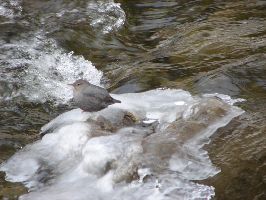
American Dipper
In the Cariboo Chilcotin, the habitat ranges from open forest with grassy ground cover to closed forest with more shrubs and mixed forb-grass-moss ground cover. The open forest will include a ground cover of bluebunch wheatgrass and a moderate cover of shrubs like snowberry, saskatoon, and juniper. Moister sites have a ground cover of pinegrass and feather moss, a shrub layer including birch leaved spirea and soopolallie and include lodgepole pine and aspen in the canopy. In the sites with the most moisture, mature stands include spruce, pine, aspen, and Douglas-fir as well as a well developed shrub layer of goosebery, black twinberry, and red osier dogwood. The wetlands (marshes, fens and wet meadows) are often surrounded by stands of willows and cottonwoods. Large areas of red-needled and dead pine trees currently blanket the region as a result of the mountain pine beetle epidemic.
Mule deer (dependent on these forests in the winter), black bear, cougar, coyote, and moose are commonly seen. A variety of bats use the area including the spotted bat and Townsend big-eared. These forests also support a diverse complement of birds that feed on the seeds and bark-insects, and small mammals—pileated woodpecker, northern flicker, red cross-bill, and northern pygmy owl are just some. Sockeye, chinook, coho, and pink salmon spawn and rear in the rivers and lakes found in these forests.
For more information about Knife Creek Research forest (an Interior Douglas-fir forest that will be visited for one of the workshops) link to http://www.forestry.ubc.ca/resfor/afrf/index.htm and click on Knife Creek.
Sub Boreal Spruce Zone
The Sub-Boreal Spruce zone is the montane zone dominating the central interior of British Columbia. It occupies gently rolling terrain of the plateaus and fingers into more mountainous areas on the western and eastern edges of the Cariboo Chilcotin. It is wetter with snowy winters and moister summers than the other regions of the Cariboo Chilcotin. Coniferous forests with extensive ground covers of herbs and mosses dominate. Wetlands are common and often extensive. These forests provide abundant habitat for wildlife. Again, there are extensive signs of red-needled and dead pine trees along with large clear-cut areas as forest harvesting is very active in this zone.
Hybrid spruce (Englemann x white spruce) and subalpine fir are the dominant climax tree species with lodgepole pine, trembling aspen and paper birch also common. The shrub layer is moderately developed and includes species ranging from thimble berry, highbush-cranberry, Sitka alder, a variety of low growing blueberries, black twinberry, soopolallie, and snowberry. The herb layer is extensive and includes kinnikinnick, bunchberry, queens cup, pyrola species, twinflower, false Solomon’s seal, pine grass, forest sedges, and many more. There is a well developed moss and lichen layer.
Wetlands are common and dot the landscape in poorly drained depressions or river ox-bows. These wetlands include sedge marshes, shrub fens, and treed fens and swamps.
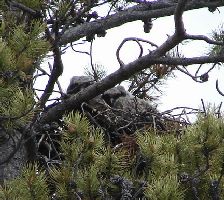
Owlets
Wildlife that inhabit this zone are adapted to either survive or avoid severe winters. Moose are the most common large ungulate. This zone provides habitat for mountain caribou (red listed species) in early winter. Black and grizzly bear are common especially along salmon bearing streams. Smaller mammals include deer mouse, snowshoe hare, marten, red and flying squirrels, and fishers. A variety of songbirds (pine siskin, yellow-rumped warbler, etc.) and a variety of woodpecker species are dependent on these mature coniferous forests. The great gray owl is common. Many of the rivers and small streams have salmon species. The Horsefly and Quesnel River are known for the extensive sockeye run.
Scout Island Nature Centre
It is the location of many of the workshops for this event. It is also a great place to go for a “walk.”
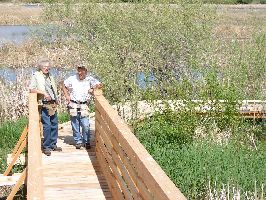
Otter Point board walk lets you walk
into the marsh
nesting at Scout Island Marsh
The Scout Island Nature Centre is operated by the Williams Lake Field Naturalists in cooperation with the Nature Trust of BC and the City of Williams Lake.
Scout Island Nature Centre, located in the heart of Williams Lake, is a tranquil oasis to view wildlife. It is a bird watcher’s paradise in the spring and fall.
The two small islands in Williams Lake, connected to the mainland by a short causeway, are directly on the flight path of hundreds of bird species that migrate from as far south as Peru and Chili right up to Alaska and the North West Territories. These birds often stop in the lush marsh at Scout Island to rest up before continuing with their journey.
Redwinged Blackbird
Rare white pelicans, swans, eagles, many species of ducks and smaller birds are just some of the wildlife you can expect to see along the network of walking trails. You might catch a glimpse of the resident families of foxes, beavers, or otters.
_resize.jpg)
_resize.jpg)
Fox Kits
Scout Island also features a Nature House where you can see interactive and live displays of plants and animals ask questions of the interpretive staff or peruse the nature bookstore and library. A viewing point platform on the roof provides a vista of the marsh and the Williams Lake River Valley below.
Trumpeter Swans at Williams Lake
Details:
Island is open year round from 8 am to duskThe Nature Centre offers discovery programs for children, families, school and community groups all year round.
Nature house is open daily May to August and weekends April, September and October
Contact: 398-8532 for more information
Williams Lake River Valley Trail
Different sites in the valley will be used for workshops and field trips. Extending from Williams Lake to the mighty Fraser River, the trail meanders with the river through forest and grassland beneath the magnificent cliffs and vistas of the valley walls. Hike or cycle the trail (11km full length or 4km the lower end). Link to http://www.williamslake.ca/index.asp?p=80 for more information. Wear good hiking shoes and carry water.
Sugar Cane and Soda Creek First Nations fished and hunted in the valley for thousands of years. Gravel extraction, saw mills and ranching extracted resources and damaged the delicate ecosystems. These areas are now being reclaimed by nature with help from the community of people who are working to restore the valley’s riparian forests and riverbanks. This valley has examples of all three types of ecosystems (grasslands, dry forests, and spruce forests) as well as marshes, rivers, and riparian forests. It is home to a diversity of plants, animals (beavers, river otter, deer, and even cougar), fungii, and a multitude of tiny organisms. It is a great place to bird and to watch butterflies and dragon flies. Year round, you will see evidence in the river of resident fish and a wide variety of stream and marsh invertebrates.